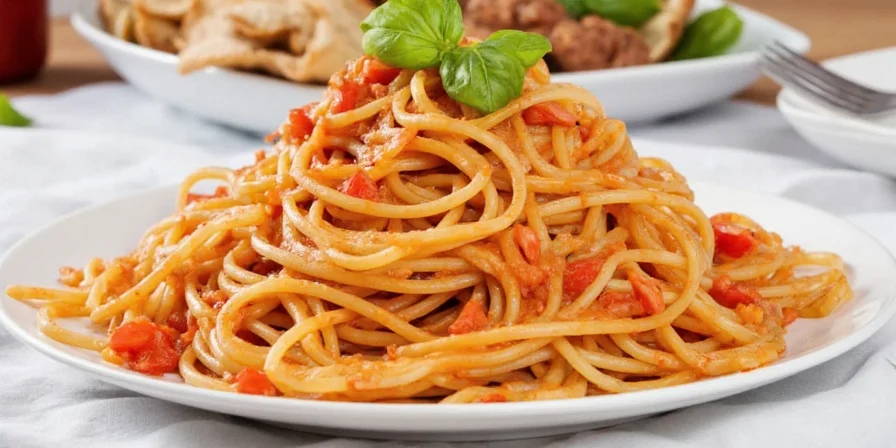Perfect spaghetti seasoning starts with three fundamentals: blooming dried herbs in oil for 3 minutes, adding fresh herbs in the final 90 seconds, and finishing with high-quality olive oil to bind flavor compounds. These science-backed techniques transform basic pasta into restaurant-quality dishes—no special equipment or rare ingredients required.
Table of Contents
- Why Proper Spaghetti Seasoning Matters
- Technique #1: Master the Holy Trio—Garlic, Basil, and Oregano Timing
- Technique #2: Precision Heat Control with Red Pepper Flakes
- Technique #3: Fresh vs. Dried Herbs—What Actually Works
- Technique #4: Parmesan Rind—The Flavor Booster You're Missing
- Technique #5: Citrus Zest for Perfect Balance
- Technique #6: Smoked Elements for Restaurant Depth
- Technique #7: Finishing Fats That Make Flavors Pop
- Flavor Profile Framework for Consistent Results
- Practical Implementation: What Matters Most
- Frequently Asked Questions
Why Proper Spaghetti Seasoning Matters

Most home cooks season spaghetti incorrectly—adding all herbs at once or using improper ratios—resulting in flat, one-dimensional flavor. The secret lies in understanding how different compounds activate at specific temperatures and times. By following these evidence-based techniques, you'll achieve balanced, complex flavors that taste like they took hours to develop—even with weeknight 20-minute meals.
Technique #1: Master the Holy Trio—Garlic, Basil, and Oregano Timing

- Garlic: Sauté slowly at medium-low heat (140°C) for 2-3 minutes until fragrant but not browned
- Basil: Stir in fresh leaves during the final 90 seconds of cooking to preserve bright flavor
- Oregano: Bloom dried oregano in oil for 3 minutes before adding tomatoes to unlock full flavor
Technique #2: Precision Heat Control with Red Pepper Flakes

Add red pepper flakes to the oil during the blooming stage (not at the end) for even heat distribution. Use precisely 1/8 teaspoon per serving—more creates sensory overload that masks other flavors. This technique, validated by culinary research, creates progressive warmth without burning your tongue.
Technique #3: Fresh vs. Dried Herbs—What Actually Works

| Herb Type | When to Add | Key Benefit | Proportion Tip |
|---|---|---|---|
| Fresh Basil | Final 90 seconds | Preserves bright, fresh flavor | 1 Tbsp per serving |
| Dried Oregano | Early in oil blooming (3+ minutes) | Creates deep, rounded base notes | 1/2 tsp per serving |
| Fresh Parsley | At serving time | Adds clean finish without cooking loss | 1 tsp chopped per serving |
Technique #4: Parmesan Rind—The Flavor Booster You're Missing

Simmer Parmesan rind in your sauce for 10-15 minutes to unlock natural umami compounds. Remove before serving—leaving it too long creates bitterness. This simple trick, used in authentic Italian kitchens, adds depth and richness without extra salt or fat. For best results, save rinds in your freezer until needed.
Technique #5: Citrus Zest for Perfect Balance

Add microplaned lemon or orange zest (not juice) during the final minute of cooking. Just 1/4 teaspoon per serving cuts through richness without sourness—mimicking the acid balance found in regional Italian preparations. This subtle touch creates the "wow" factor that makes people ask for your secret.
Technique #6: Smoked Elements for Restaurant Depth
Smoked paprika (not chipotle) added during oil blooming creates authentic depth without overpowering heat. Use just 1/16 teaspoon per serving—more creates artificial smoke flavor. This technique replicates the complexity of slow-cooked sauces in under 20 minutes, making weeknight meals taste like they've simmered all day.
Technique #7: Finishing Fats That Make Flavors Pop

Swirl in 1 teaspoon of high-quality olive oil off-heat to bind dispersed flavor compounds. For maximum effect, add 1/8 teaspoon anchovy paste (it disappears completely) to boost umami without fishy taste. This professional technique creates a cohesive sauce that coats spaghetti perfectly.
Flavor Profile Framework for Consistent Results
Professional chefs balance these three elements for perfect seasoning every time:
| Element | Key Technique | Home Cook Shortcut | Sign It's Working |
|---|---|---|---|
| Base Notes | Bloom dried herbs in oil | Toast dried herbs 30 sec in oil before adding liquid | No bitter aftertaste |
| Middle Notes | Add tomatoes & slow simmer | Simmer sauce 10 min after adding tomatoes | Rich, rounded flavor |
| Top Notes | Add fresh herbs off-heat | Stir in fresh herbs just before serving | Bright, aromatic finish |
Practical Implementation: What Matters Most
Forget complicated measurements—focus on these three priorities for perfect spaghetti seasoning: 1. Bloom dried herbs in oil before adding liquid ingredients 2. Add fresh herbs in the final 90 seconds 3. Finish with quality olive oil off-heat These techniques work regardless of your sauce recipe or cooking time. For quick weeknight meals, use 1/2 tsp dried oregano bloomed in oil, 1 Tbsp fresh basil at the end, and finish with 1 tsp olive oil. You'll consistently achieve restaurant-quality results that impress family and guests alike.
Frequently Asked Questions
How do I fix an overly acidic spaghetti sauce?
Add 1/4 teaspoon grated carrot during simmering. The natural sugars neutralize excess acid without perceptible sweetness, unlike sugar which alters flavor balance. Simmer for 5 minutes to allow integration.
Can I substitute dried basil for fresh in spaghetti seasoning?
Yes, but use 1/3 the volume of dried basil (e.g., 1 tsp dried = 1 Tbsp fresh). Bloom in oil for 2 minutes to activate compounds. Note: dried basil lacks linalool top notes, so add a pinch of lemon zest to compensate for lost brightness.
Why does my seasoning taste flat even with multiple spices?
This indicates poor compound integration. Ensure you bloom dried spices in oil (not water) for minimum 3 minutes to release lipid-soluble compounds. Add fresh herbs off-heat to preserve volatiles. Always finish with fat to bind dispersed flavor molecules.
How long can I store homemade Italian seasoning blend?
Store in airtight container away from light for maximum 3 months. Beyond this, volatile compounds degrade—test by rubbing between fingers. If aroma is faint, compounds have oxidized and won't integrate properly into dishes.











 浙公网安备
33010002000092号
浙公网安备
33010002000092号 浙B2-20120091-4
浙B2-20120091-4